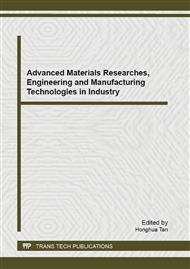[1]
S. Costanzo, A. Cusumano, C. Giaconia, G. Giaconia, Preservation of the artistic heritage within the seat of the Chancellorship of the University of Palermo A proposal on a methodology regarding an environmental investigation according to Italian Standards., Building and Environment, 41: 1847–1859, (2006).
DOI: 10.1016/j.buildenv.2005.06.010
Google Scholar
[2]
S. B Randazzo., Religiosity. Mystagogy and popular piety in Sicily, Ed. Biblioteca Francescana, Palermo, (1992).
Google Scholar
[3]
G. Cannistraro, M. Cannistraro, A. Mazzullo, R. Restivo, A new diagnostic investigationmethod aimed to the environmental conservation of artefacts and articles subjected to art and architecture protection, IN_BO. Ricerche e progetti per il Territorio, la Città e l'Architettura, vol. 3(5), Pag. 129-138 ISSN: 2036-1602, Bologna, (2013).
Google Scholar
[4]
G. Cannistraro, M. Cannistraro, O. Fiandaca, R. Restivo, A method of investigation for a diagnostic screening of energy andenvironmental quality of architectural heritage in Messina, IN_BO. Ricerche e progetti per il territorio, la Città e l'Architettura, vol 3(5), Pag. 139-160 ISSN: 2036-1602, Bologna, (2013).
Google Scholar
[5]
G. Cannistraro, M. Cannistraro, R. Restivo, Thermohygrometric monitoring using wireless sensors: study of seventeenth-century church'smicroclimatic conditions andenclosed reliquary, Science Series Data Report Journal, pag. 101-123 - Vol 4 No. 4; Issn: 1307-119X , (2012).
Google Scholar
[6]
S. Costanzo, A. Cusumano, C. Giaconia, G. Giaconia, Preservation of the artistic heritage within the seat of the Chancellorship of the University of Palermo A proposal on a methodology regarding an environmental investigation according to Italian Standards., Building and Environment, 41: 1847–1859 (2006).
DOI: 10.1016/j.buildenv.2005.06.010
Google Scholar
[7]
M. La Gennusa, G. Rizzo, G. Scaccianoce, F. Nicoletti Control of indoor environments in heritage buildings: experimental measurements in an old Italian museum and proposal of a methodology,. Journal of Cultural Heritage, 6: 147–155 (2005).
DOI: 10.1016/j.culher.2005.03.001
Google Scholar
[8]
G. Cannistraro, M. Cannistraro, R. Restivo, The conservation of sacred art: a case study purpose to search for an index of correlation between particle concentration and mass of fine dust, Science Series Data Report Journal, pag. 63-84 - Vol 4, No. 4; Issn: 1307-119X , (2012).
DOI: 10.1016/j.tsep.2019.100405
Google Scholar
[9]
B. Harder, Holy Smoke: Burning Incense, Candles Pollute Air in Churches, Science News, Vol. 170, August 19, (2006).
Google Scholar
[10]
C. Saiz-Jimenez, Air Pollution and Cultural Heritage, Taylor& Francis, (2004).
Google Scholar
[11]
Decree No. 60 of 2. 4. 2002, Transposition of Council Directive 1999/30/EC of 22 April 1999 relating to limit values of quality 'ambient air for sulfur dioxide, nitrogen dioxide, oxides of nitrogen, particulate matter and lead and Directive 2000 / 69/CE relating to limit values of quality ambient air for benzene and carbon monoxide.
DOI: 10.3403/03238765
Google Scholar
[12]
Legislative Decree n. 112/98, Guideline on technical-scientific criteria and standards of operation and development of museums.
Google Scholar
[13]
R. Restivo, The role of environmental parameters in the conservation of sacred works of artPh. D Thesis. in Civil and Environmental Engineering - University of Messina, (2013).
Google Scholar


